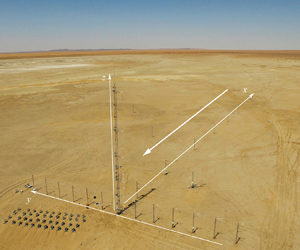Article contents
Amplitude modulation in particle-laden atmospheric surface layers
Published online by Cambridge University Press: 16 February 2023
Abstract

Particle effects on the amplitude modulation are investigated in this study based on observational data with various mass loading acquired from long-term measurements of aeolian sandstorms in high-Reynolds-number ( $Re_{\tau }\sim O(10^6)$) near-neutral atmospheric surface layers. In both particle-laden and unladen flows, in addition to the positive top–down modulation behaviour in the logarithmic region, a significant modulation effect that exists for some specific motions is also found for the single-point amplitude modulation. The most energetic turbulent motions exhibit the strongest modulation effect, and the modulating signals do not change with the small-scale motions being modulated. In particle-laden flows, the length of the most energetic structure is almost constant, thus the scales of the modulating signal and carrier signal are hardly affected by particles. However, the addition of particles changes the distribution of energy between multi-scale turbulent motions. The kinetic energy of the large-scale component is less enhanced than the total kinetic energy by particles. This leads to a reduced energy proportion of the large-scale component and an augmented one of the small-scale component. Moreover, the particles produce a large damping in the degree of the amplitude modulation and move down the positions of the modulating signals and carrier signals corresponding to the strongest inter-layer modulation, but the damping is weakened with the wall-normal distance due to the decreased mass loading. This study may provide a more general insight into the modulation mechanism between multi-scale turbulent motions and the effect of particles on turbulence.
$Re_{\tau }\sim O(10^6)$) near-neutral atmospheric surface layers. In both particle-laden and unladen flows, in addition to the positive top–down modulation behaviour in the logarithmic region, a significant modulation effect that exists for some specific motions is also found for the single-point amplitude modulation. The most energetic turbulent motions exhibit the strongest modulation effect, and the modulating signals do not change with the small-scale motions being modulated. In particle-laden flows, the length of the most energetic structure is almost constant, thus the scales of the modulating signal and carrier signal are hardly affected by particles. However, the addition of particles changes the distribution of energy between multi-scale turbulent motions. The kinetic energy of the large-scale component is less enhanced than the total kinetic energy by particles. This leads to a reduced energy proportion of the large-scale component and an augmented one of the small-scale component. Moreover, the particles produce a large damping in the degree of the amplitude modulation and move down the positions of the modulating signals and carrier signals corresponding to the strongest inter-layer modulation, but the damping is weakened with the wall-normal distance due to the decreased mass loading. This study may provide a more general insight into the modulation mechanism between multi-scale turbulent motions and the effect of particles on turbulence.
- Type
- JFM Papers
- Information
- Copyright
- © The Author(s), 2023. Published by Cambridge University Press
References
- 12
- Cited by



